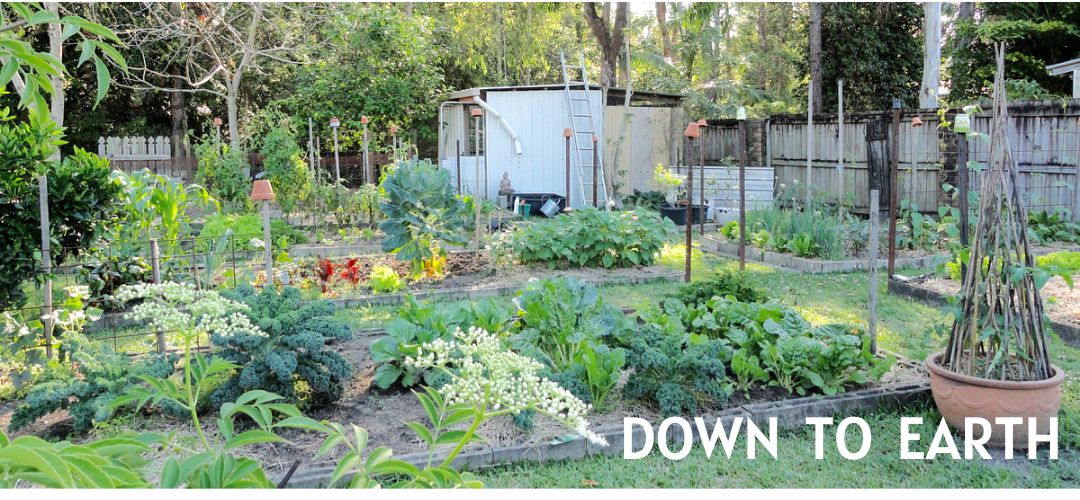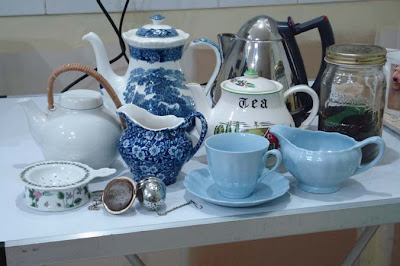It's Thanksgiving Day in America today so I'd like to wish my American friends happy Thanksgiving. I hope you all have a wonderful day with family and friends.
Some of my tea making paraphernalia. I know I have too much of this but tea makes me happy, I enjoy making good tea for friends and family and I love having morning and afternoon tea. So for those reasons, I'm keeping all my tea gear, none of it will be removed in a decluttering frenzy in the foreseeable future. I think I have nine teapots. I can't check now because most of them are packed away somewhere. The little white teapot here I bought in the 60s when I first left home - it's a Finlandia. The blue and white tea/coffee pot is from the 1970s, it's an English Adams, not expensive, but my first blue and white set of crockery. The pot with "tea" on it is a 1930s set Made in Japan. I also have a set of canisters that match it which I bought off ebay about six or seven years ago. The little blue cup and saucer and milk jug are similar to ones my Mum had when I was growing up. They were also bought on ebay several years ago. Kettle at the back, tea balls and strainer at the front.
I was asked in comments and emails how to brew a good pot of tea, and thought it was an excellent idea for a post.
Tea is the second most popular drink in the world. Water is the most popular. Like most people, I've been drinking tea made with tea bags - I found a well priced organic black tea bag at Aldi and have been using that. But over the past couple of months I've gone back to real tea, and I say 'real tea' because tea bags are made with the fannings (the worst grade of tea) and tea dust. There is such a difference in the taste that I know if you've only used tea bags, tea made with loose leaves will convert you to making tea in a pot.
You'll need fresh water, a kettle, a china, glass or pottery tea pot, tea leaves, a tea cosy (if you're in a cold climate), tea strainer or tea ball (to stop the leaves going into your cup), and ...
Time. After your water is boiled, it will take about five minutes to make a pot of tea.
You must have fresh water from the tap to make good tea. Tea needs dissolved oxygen in the water and if you use water that's been sitting in the kettle for a while, that's not good enough.
While I'm sure there are many ways to make a good pot of tea, this is how I make it:
You'll need fresh water, a kettle, a china, glass or pottery tea pot, tea leaves, a tea cosy (if you're in a cold climate), tea strainer or tea ball (to stop the leaves going into your cup), and ...
Time. After your water is boiled, it will take about five minutes to make a pot of tea.
You must have fresh water from the tap to make good tea. Tea needs dissolved oxygen in the water and if you use water that's been sitting in the kettle for a while, that's not good enough.
While I'm sure there are many ways to make a good pot of tea, this is how I make it:
- Fill your kettle and boil the water.
- While the kettle is boiling, prepare your pot and the tea cups. If you're putting the tea in a tea ball, do that, making sure the tea ball is suitable for the size of the pot. Don't put the tea in the pot yet.
- When the water is boiled, pour a small amount into the pot and swish it around the pot to warm it. Tip that water out.
- Add the tea leaves to the pot. The usual measure is one teaspoon for each person and one for the pot. So if you're making two cups, you'd add three teaspoons of tea leaves and enough water for almost three cups.
- Pour the boiling tea over the tea leaves and place the lid on the tea pot. The water must be boiling.
- If you're in a cold climate, place a tea cosy over your teapot. The tea will stand now for a few minutes and it must be kept hot. I use a tea cosy here in winter but not in summer.
- Allow the tea to steep for between three to five minutes. I drink mine after about three minutes.
- If you take your tea with milk, it is added after the tea is poured, and although this is firmly adhered to in certain parts, (ahem England : ) ), it really doesn't matter when you add the milk. Some say you scald the tea when you add it first, I doubt very much that it matters.
- Sugar or honey is generally used to sweeten tea and some add a squeeze of fresh lemon. But don't add milk if you add lemon as it will curdle the milk.
I have my tea black with one spoon of honey. MMmmmmmm. Please don't flavour your tea too much, it masks the true flavour of good tea. All those vanilla, apple, apricot and strawberry teas, aren't the types of tea I'm talking about here. They are tea bags made with fannings and with (usually) artificial flavourings added. If you want to drink good tea for flavour and health, you'll choose a good quality loose tea, have it black or with milk and with sweetener or without. That's it.
TYPES OF TEA
All tea comes from the plant Camellia sinensis. After the tea is picked, it is processed in various ways to produce the different teas we drink. Tea is generally named for the region it originates from.
Green tea: Tea that is dried immediately after harvesting.
Black tea: Tea that is dried and fermented, it's stronger than green tea. Black tea comes in various strengths and flavours. There is Darjeeling (my favourite), Orange Pekoe (which not orange flavoured), Earl Grey (black tea with bergamot oil added), Ceylon tea (for my fellow Australians, this is the tea that is sold as Billy Tea, Lan Choo, Bushells, King Tea etc.) Ceylon tea is my everyday cuppa.
TYPES OF TEA
All tea comes from the plant Camellia sinensis. After the tea is picked, it is processed in various ways to produce the different teas we drink. Tea is generally named for the region it originates from.
Green tea: Tea that is dried immediately after harvesting.
Black tea: Tea that is dried and fermented, it's stronger than green tea. Black tea comes in various strengths and flavours. There is Darjeeling (my favourite), Orange Pekoe (which not orange flavoured), Earl Grey (black tea with bergamot oil added), Ceylon tea (for my fellow Australians, this is the tea that is sold as Billy Tea, Lan Choo, Bushells, King Tea etc.) Ceylon tea is my everyday cuppa.
TEA COSIES
You'll need a tea cosy if you live in a cold climate.
Tea cosy patterns here and here, Australian 1930s crocheted tea cosy and a vintage tea cosy. I wanted to show you my favourite tea cosy that Tricia made for me, a patchwork one, but I can't find it with everything packed away for the renovations. I'll try to remember it when everything is back to normal.
You'll need a tea cosy if you live in a cold climate.
Tea cosy patterns here and here, Australian 1930s crocheted tea cosy and a vintage tea cosy. I wanted to show you my favourite tea cosy that Tricia made for me, a patchwork one, but I can't find it with everything packed away for the renovations. I'll try to remember it when everything is back to normal.
I hope you all have the chance to make a pot of tea soon, and to sit and relax with the warming flavour of it.

